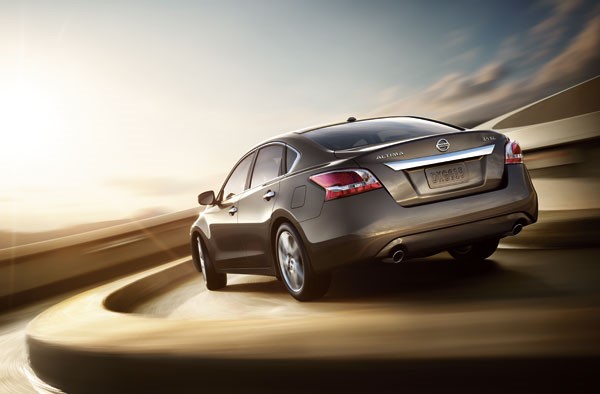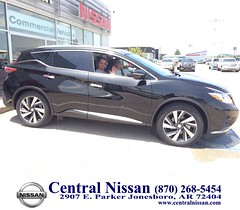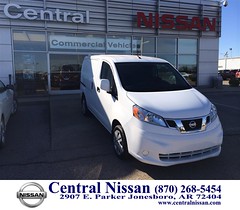The 2016 Nissan Titan XD is an all-new, diesel-powered large truck with more towing and hauling capability than regular “half-ton” pickups. But although it qualifies for heavy-duty status, it’s not quite a direct rival to established HD trucks from Ford, Ram and General Motors. Instead, the crew-cab Titan XD aims for a middle ground that has emerged as those products have moved upmarket. If you want to save some money but need something stronger than the half-ton Ram 1500 EcoDiesel, this Nissan is designed to hit the spot.

Some might find the 2016 Nissan Titan XD’s front-end styling a bit challenging, but its capabilities command respect.
The Titan XD is technically a heavy-duty pickup because its Gross Vehicle Weight Rating (GVWR) exceeds 8,500 pounds, thanks to beefy components previously developed and proven in Nissan’s NV line of commercial vans. For XD duty, the fully boxed ladder frame was modified and stretched to a 151.6-inch wheelbase that can accommodate the standard crew-cab layout and 6.5-foot bed. Interestingly, heavy-duty trucks are legally bound to a bed length of at least 6 feet, which is why the XD doesn’t offer a shorter bed like regular-duty crew cabs. This works out better in terms of versatility, but the end result is a truck that’s about as unwieldy as 2500-series crew-cab models, measuring more than 20 feet from nose to tail.
One of the XD’s most notable features is the brand-new Cummins 5.0-liter V8 diesel engine under the hood, which makes 310 horsepower and 555 pound-feet of torque. That’s less output than the Big Three heavy-duty diesels, but considerably more than the Ram 1500 EcoDiesel (240 hp and 420 lb-ft). By the numbers, the Ram EcoDiesel’s towing capacity tops out at 8,870 pounds in crew-cab form, while the typical 2500-series HD diesels can tow 14,000 to 17,000 pounds. There’s a lot of room in between, and the 2016 Titan XD exploits it with a healthy 12,314-pound maximum that might just be all you need.
Of course, it might also be more than you need, in which case the forthcoming regular-duty Nissan Titan could be a better fit. Aside from slightly slimmer front-end styling (because the hefty diesel V8 won’t be offered) and an available 5.5-foot short bed, the half-ton Titan will look similar and come with basically the same interior. As for closer Titan XD rivals, the abovementioned Ram 1500 EcoDiesel remains your only choice for diesel power in a regular-duty truck, while the recently redesigned Chevrolet Silverado 2500HD and the tried-and-true Ram 2500 and Ford F-250 offer mega-capable diesel engines. If something in the middle feels right to you, the 2016 Nissan Titan XD is a must-drive.
No Video Content
Body Styles, Trim Levels, and Options
All 2016 Nissan Titan XD heavy-duty pickups come with a crew cab, a 6.5-foot bed and your choice of rear- or four-wheel drive. The crew cab can seat five or six, depending on trim and equipment. There are five trim levels: S, SV, Pro-4X, SL and Platinum Reserve.
The entry-level S work truck starts things off with 17-inch steel wheels, a lockable damped tailgate, a manual-sliding rear window, manual side mirrors and remote keyless entry. Inside you’ll find power windows, air-conditioning, cruise control, Bluetooth, a tilt-and-telescoping steering wheel, a bench front seat, 60/40-split folding rear seatbacks and cloth-and-vinyl upholstery. The audio system features a 5-inch color display and provides USB connectivity and an auxiliary audio jack. Buy the S Convenience and Utility package to add a spray-in bedliner, a front overhead console, a receiver hitch and a 7-pin wiring harness connector at the rear bumper.
The SV adds the overhead console as standard, and it also gets power side mirrors with integrated turn signals, a few dabs of chrome, upgraded instrumentation, satellite radio, Siri Eyes-Free and NissanConnect mobile-app integration. The SV Tow Convenience package combines the S trim’s optional receiver hitch and wiring harness connector with heated manually extendable tow mirrors, a trailer brake controller and an integrated gooseneck hitch.
Choose the comprehensive SV Comfort and Convenience package to get 20-inch alloy wheels, automatic headlights and wipers, foglights, front and rear parking sensors, a blind-spot monitor with rear cross-traffic alert, a power-sliding rear window, step rails, keyless entry and ignition, an auto-dimming rearview mirror, a leather-wrapped steering wheel, upgraded cloth upholstery, heated front bucket seats with 10-way power adjustments for the driver (including power lumbar), dual-zone automatic climate control, a center console with rear power outlets and climate vents, a rearview camera and a 7-inch infotainment display with a navigation system. The SV Utility package adds a lockable storage box under the backseat, a Utili-Track bed rail system with four moveable tie-down cleats, LED cargo box illumination, the spray-in bedliner and a 120-volt in-bed power outlet.
Next up is the Titan Pro-4X, which receives dark-finished 18-inch wheels with all-terrain tires, off-road-tuned Bilstein shocks, a lockable rear differential, skid plates, hill descent control and special cloth-and-vinyl upholstery. The Pro-4X also boasts LED headlights, the spray-in bedliner, a towing package akin to that of the SV, voice controls and most of the equipment from the SV Comfort and Convenience package. The optional Pro-4X Convenience package builds from there with remote engine start, an auto-dimming driver-side mirror, unique leather upholstery with contrast stitching, a four-way power passenger seat, a heated steering wheel, heated rear seats, a power-adjustable steering wheel and driver memory settings.
Also offered on the Pro-4X is a Utility and Audio package that combines the SV Utility package with a Rockford Fosgate audio system featuring 12 amplified speakers and a subwoofer. And then there’s the Pro-4X Luxury package, which adds a pair of removable “Titan box” in-bed storage compartments, a surround-view camera system and ventilated front seats.
 The available “Titan box” bedside storage containers are great for holding tools or even cold beverages.
The available “Titan box” bedside storage containers are great for holding tools or even cold beverages.
The SL trim does away with the Pro-4X off-road gear, instead providing standard 20-inch alloy wheels and copious chrome exterior trim along with relatively understated leather upholstery. The SL also gets essentially all of the Pro-4X’s optional packages except the Luxury package as standard, though the rear-seat heaters are curiously unavailable. Also absent is the Luxury package’s surround-view camera; however, the Titan boxes can be added separately.
Pretty much every upgrade mentioned so far (except the Pro-4X off-road bits) comes standard on the Platinum Reserve, a loaded truck with a higher grade of interior and exterior finish. Outside, unique dark chrome plating adorns the 20-inch wheels and various trim accents, while the front seats are sumptuous black-and-brown pleated leather buckets (heated and cooled, of course). The rear-seat heaters come standard, as do aluminum sill plates and wood interior accents. Exclusively offered on the Platinum Reserve is a rear-seat DVD entertainment system with headrest-mounted displays and wireless headphones.
Powertrains and Performance
The 2016 Nissan Titan XD is powered by a turbocharged 5.0-liter diesel V8 engine that makes 310 hp and 555 lb-ft of torque. Rear-wheel drive (RWD) is standard on all but the Pro-4X, which comes standard with a four-wheel-drive system (4WD) that’s optional on the others. The transmission on every Titan XD is a six-speed automatic.
In Edmunds track testing, the heaviest version — a 4WD Platinum Reserve — recorded a zero-to-60-mph time of 9.6 seconds, which can only be described as disappointing. But torque and towing are what the XD is all about. The 3.92-to-1 axle ratio is the sole offering, so the hitch is all you need for heavy towing. The lighter S 4×2 tops the list with 12,314 pounds of towing capacity or 2,091 pounds of payload, while the heavier 4WD Platinum Reserve can tow 10,610 pounds or haul 1,470 pounds. In between, the versatile Pro-4X can tow 11,784 pounds or tote 1,733 pounds.
Fuel economy is a major diesel selling point, but like all other heavy-duty trucks, the XD is exempt from fuel economy testing and labeling. We spent nearly 1,200 miles in a Platinum Reserve 4×4 and averaged 16 mpg. Our worst city-dominated tank was 13.8 mpg and our best all-highway tank was 20.8 mpg.
Range is ultimately limited by the standard 26-gallon fuel tank, the only offering. And the small 4.5-gallon diesel exhaust fluid (DEF) tank may well need topping-up during a particularly long road trip.
Safety
Every 2016 Nissan Titan XD comes standard with stability and traction control, antilock disc brakes, front side airbags and full-length side curtain airbags with rollover deployment sensors. The front seatbelts have force-limiting pre-tensioners and the backseat has LATCH anchors and seatbelts with automatic locking retractors to ease the installation of child seats.
A rearview camera, front and rear parking sensors and a blind-spot monitor with rear cross-traffic alert comes standard on the Pro-4X, SL and Platinum Reserve and can be added to an SV via that trim’s Comfort and Convenience package. The Platinum Reserve’s standard backup camera is in fact Nissan’s full 360-degree Around View Monitor multi-camera system, which can be added to a Pro-4X via the Luxury package.
The SL and Platinum Reserve come with NissanConnect Services, a subscription-based service that includes automatic crash notification, stolen vehicle recovery assistance and one-touch access to roadside assistance. It’s added to the Pro-4X when you buy the Convenience package.
Interior Design and Special Features
The 2016 Nissan Titan XD deviates from past Titans in its use of a column shifter, with manual-shift toggles and a tow-haul switch out near the end. This seemingly small change transforms the interior. It makes possible the three-passenger front bench seat in the S and SV, and it reduces clutter and opens up valuable central real estate for storage when the front bucket seats are present. It also simplifies the layout of the nicely arranged climate control interface and opens up a ready home for the integrated trailer brake controller, which is at once out of the way and close at hand.
 The 2016 Titan XD’s cabin isn’t necessarily a standout, but we like its simplicity and space.
The 2016 Titan XD’s cabin isn’t necessarily a standout, but we like its simplicity and space.
The rest of the dash is peppered with familiar gauges and switchgear that are pure Nissan. It’s all logically arrayed and pleasing to the touch, but some of the buttons do seem small against the backdrop of the XD’s massive cabin. Indeed, the Titan XD provides an abundance of interior room. There’s easily enough space for a 6-foot-2-inch adult to comfortably sit behind his own adjusted driver seat. Front or back, the leather seats are inviting and offer long-distance support, though the pleated Platinum Reserve seats don’t offer a clear advantage over the others apart from styling.
In terms of technology, the 7-inch touchscreen entertainment and navigation system works well and is easy to use, but it’s not really any more advanced or capable than what Nissan has been offering for the last several years. Competing trucks offer slicker interfaces with a greater depth of capability. The same can be said for the XD’s driver information screen between the gauges: it’s straightforward and does the job, but it’s not class-leading.
You can flip up the rear seat bottoms when hauling cargo in the cab, but the floor below isn’t entirely flat. To remedy this there’s a flip-out platform that stands about 3 inches above the carpet on fold-down legs, just like in Ram trucks. The Utility packages include a lockable cab-wide bin that’s concealed under the seat bottom and just might hold a fishing pole or two.
Driving Impressions
The 2016 Nissan Titan XD’s 5.0-liter diesel V8 engine helps this big truck move out smoothly and is relatively quiet as it goes about its business. There’s plenty of torque for anything from around-town driving to freeway merges to hill climbing. However, the Titan XD’s formidable weight (7,080 pounds on our scales for the 4WD Platinum Reserve) puts a damper on acceleration despite the V8’s significant output, as our track test results illustrate.
 Although acceleration is leisurely at full whack, the 2016 Titan XD has more than enough motor for regular tasks.
Although acceleration is leisurely at full whack, the 2016 Titan XD has more than enough motor for regular tasks.
With the possible exception of low-speed crawling through freeway traffic, the six-speed transmission makes all the right moves. Shifting is smooth and positive, and the gearbox is especially adept when climbing grades with a trailer latched behind, where the expansive torque of the V8 helps it hold gears confidently and resist dithering. On the subsequent downslope, a tap of the brakes in tow-haul mode engages a downhill speed control feature that uses transmission downshifts to regulate descent speed.
The big Titan XD goes down the road with a sense of authority and is generally impervious to crosswinds. The heavy-duty recirculating-ball steering system doesn’t impart a strong sense of connection as it goes about its business, but at least it makes the truck feel manageable during low-speed maneuvers and U-turns, which can test your patience on account of the gigantic 53.9-foot turning circle. All three versions we’ve sampled — a Pro-4X, an SL and a Platinum Reserve — delivered a calmer ride on a variety of surfaces than your typical 2500-series truck. The Pro-4X emerged as our favorite due to its combination of special suspension tuning and taller tires, which did a better job of filtering out coarse road textures and sharp edges alike.





 The Pro-4X trim level comes with off-road-ready hardware, including special tires, shocks and skid plates.
The Pro-4X trim level comes with off-road-ready hardware, including special tires, shocks and skid plates. The 2016 Frontier’s interior design and trim are from an earlier era at Nissan, but most of the controls are user-friendly.
The 2016 Frontier’s interior design and trim are from an earlier era at Nissan, but most of the controls are user-friendly. The 2016 Nissan Frontier delivers capable acceleration with the optional V6 engine, but rivals offer better overall performance.
The 2016 Nissan Frontier delivers capable acceleration with the optional V6 engine, but rivals offer better overall performance.


 With upscale materials and a standard 8-inch touchscreen, the 2016 Nissan Maxima is a step above more common family sedans.
With upscale materials and a standard 8-inch touchscreen, the 2016 Nissan Maxima is a step above more common family sedans. The 2016 Maxima’s intimate, well-trimmed interior is one of its strongest suits.
The 2016 Maxima’s intimate, well-trimmed interior is one of its strongest suits. If you’re looking for a sporty family sedan, the 2016 Nissan Maxima should be an excellent choice.
If you’re looking for a sporty family sedan, the 2016 Nissan Maxima should be an excellent choice.
 The available “Titan box” bedside storage containers are great for holding tools or even cold beverages.
The available “Titan box” bedside storage containers are great for holding tools or even cold beverages. The 2016 Titan XD’s cabin isn’t necessarily a standout, but we like its simplicity and space.
The 2016 Titan XD’s cabin isn’t necessarily a standout, but we like its simplicity and space. Although acceleration is leisurely at full whack, the 2016 Titan XD has more than enough motor for regular tasks.
Although acceleration is leisurely at full whack, the 2016 Titan XD has more than enough motor for regular tasks.
 Come in for a test drive of our 2016 models at
Come in for a test drive of our 2016 models at 













